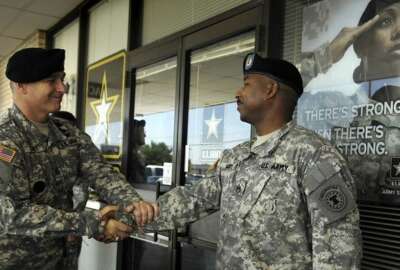
The Army has ideas for reducing civilian time-to-hire
The Army is still drafting an implementation plan for the civilian employee side of its new, overarching "People Strategy." But officials are previewing some of the...
Army leaders say they’re committed to bringing modern talent management principles into their personnel system — not just for soldiers — but for civilian employees too.
That second category is in some ways trickier, because the Army can’t overhaul the federal civil service system all by itself. But officials say there’s a lot they can do, including, hopefully, a significant acceleration of the hiring process.
Like the overarching “People Strategy” the Army debuted earlier this week, the implementation plan specific to civilian workers will cover four lines of effort: Acquiring, developing, employing and retaining talent. Officials say the “acquiring” line — the hiring process — will be the main pillar.
The civilian implementation plan is still in draft form, but Army HR officials say they have several ideas that are under consideration for the final version, including some that could be implemented without changes in law. Many of them are focused on time-to-hire.
“One of the reasons that the process takes too long is a valid reason: we do have a law that governs civilian personnel and the hiring process,” Carol Burton, the director of the Army Civilian Human Resources Agency (CHRA) told an audience of civilian workers at the Association of the U.S. Army’s annual conference in Washington on Wednesday. “We’re willing to try initiatives to reduce the hiring time, but we still have to protect merit system principles. And I think we have a really good way forward.”
For instance, Burton said the Army is exploring ways to expedite the process of sending lists of job candidates to hiring managers.
“If we’re hiring a pediatric cardiologist, we probably don’t need to go through an extensive ranking process when there’s only four candidates. But if we have a position where there are 600 candidates, perhaps there would be some value,” she said. “What we’re doing differently this year is we’re giving the selecting official the option of using an expedited referral list. Do you want everyone that applied who is just minimally qualified, or would you like us to do the ranking for you?”
In other cases, officials think they can speed up the hiring process by giving managers themselves more discretion to identify job candidates. Burton said the Army is experimenting with a process the Navy first piloted for its civilian employees, letting managers put geographic or other boundaries around who’s allowed to apply. The Army will be testing the process in the Far East later this fiscal year.
“The manager can choose to limit the area of consideration to a smaller candidate pool than just the entire Army. So if in his or her work unit, they know that there’s 10 highly-qualified people, we can limit that area of consideration,” she said. “That does two things: One, it’s less work for CHRA, because don’t have to go through all of those resumes. But it’s also less work for the manager to not have to sort through perhaps 300 applications.”
Related Stories
In new batch of federal hiring advice, OPM urges agencies to review how they assess job candidates
And although there’s not much the Army can do to speed up the security clearance process on its own, Burton said the service is looking into ways to let at least some new hires get started in their jobs before their clearance applications are completely investigated and adjudicated.
“We have a streamlined vetting process for positions that are both nonsensitive and that require a secret clearance, where the employee can onboard after just the FBI check. That usually takes about 24 hours, and that only applies if there’s no derogatory information,” she said. “We’re also experimenting with allowing individuals to onboard after the drug test, but prior to the results being received. That’s quite controversial, because it does put the agency at risk, but I would argue that only 1% of applicants come up hot on a drug test, and it’s minimal risk. We’re also doing the same with pre-employment physicals.”
Officials have hinted that the Army’s implementation plan will also lean heavily on direct hire authorities Congress has already granted agencies.
The Army is already using those authorities in pockets – including one very large pocket, the Army Corps of Engineers, one of the government’s largest civilian employers.
Lt. Gen. Todd Semonite, the Corps’ commander, said his organization has already cut its average time to hire to 80 days, compared to an Army-wide average of 133 days.
“We go very, very big into direct hire authority, and it’s helped me immensely. Right now, I think 94% of our job series, we can do direct hire,” he said. “I don’t know where the apprehension is. A lot of times it’s because people are worried we’re not going to hire veterans. But we’re at 40% veterans in the Corps. So why wouldn’t we continue to unleash these organizations to be able to [direct] hire?”
But Army officials say they will eventually need Congress to make at least some changes in Title V — the section of federal law that governs most of the federal civil service — if they’re going to attain the hiring system they want.
Latest Defense News
But in the meantime, the Army believes it can make significant improvements in its civilian personnel system just by virtue of bringing it under the umbrella of the newly-released people strategy, which they say will drive action and connect the initiative to budget dollars.
“Right now today, who has responsibility for recruiting Army civilians? The answer is nobody,” Burton said. “But in the Army People Strategy, for the first time ever, we’ll have a governing body for recruitment and a requirement to fund recruitment. So rather than all of us just trying to do our own thing and trying to find the applicants, we now have a requirement for a structure. So I feel really good about the future.”
Copyright © 2025 Federal News Network. All rights reserved. This website is not intended for users located within the European Economic Area.
Jared Serbu is deputy editor of Federal News Network and reports on the Defense Department’s contracting, legislative, workforce and IT issues.
Follow @jserbuWFED







